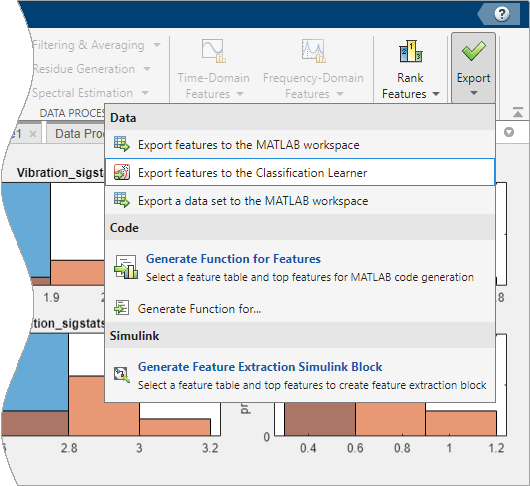Generate Features Automatically in Diagnostic Feature Designer
When you import data into Diagnostic Feature Designer, you can apply specific data processing and feature extraction options to generate and rank a feature set from your data. You can also generate and rank a feature set automatically using Auto Features. When you select one or more signals or spectra, Auto Features computes a predefined set of features that are appropriate for the variable type. The automatic computations include:
Deriving intermediate variables to use for feature extraction, such as spectra and time series signals
Extracting the features from the expanded variable set
Ranking the features and plotting the histograms of top-ranked features.
With Auto Features, you can generate standard, advanced, and rotating machinery features.
Standard — Core features, including signal, spectral, and some time-frequency features
Advanced — Signal features that require more complex computations such as residual signals and detrended time series
Rotating Machinery — Specialized features for rotating machinery that incorporate rotation rate
The following figure illustrates the computation flow for the features.
To use Auto Features, perform the following general steps:
Select a variable, such as a signal or spectrum, in the Variables pane. To select more than one variable, use Ctrl-click to add to the variable selection. The variables do not have to have the same data type.
In the Feature Designer tab, click Auto Features.
Confirm the computational settings in the Configuration pane of the Auto Features dialog box.
In the Features to Generate pane, select Standard for general features, Rotating Machinery for rotating machinery features, or both.
In the Settings pane, specify any combination of general, advanced, and rotating machinery categories.
General tab: choose whether to plot the histograms and specify the number of top-ranked features to plot.
Rotating Machinery tab:
Specify the rotation rate as a constant RPM value or as a tacho signal from your variables list. if you specify a tacho signal, also specify the number of pulses per rotation
Specify the TSA filter domain as either order or frequency and provide the orders of rotation in the machinery.
Click Compute.
Once you have generated the feature set, you can continue to derive new variables and add new features. Alternatively, you can immediately export the feature set directly to Classification Learner.
The following sections provide more information about the general workflow.
Set Up Auto Features Computation
To set up an Auto Features computation, select one or more variables and, in the Feature Designer tab, click Auto Features.

The Configuration pane of the Auto Features dialog box displays information that includes the selected variables, the feature table to add features to, and the number of features to generate. In the following example figure, a selection of a specific signal results in the app identifying 108 time-domain features and 6 frequency-domain features for generation. These features include both general and rotating machinery features.

The Configuration pane also lists the status of computational options such as parallel computing. If you want to change any of these options or if you want to add an additional variable for feature generation, click Cancel, and make the necessary changes in the app options and variable selections. Then click Auto Features once more to proceed.
The General tab of the Settings pane lets you choose to plot the histograms automatically after the features are generated and ranked. To do so, select Plot feature histograms, and then specify the number of top features to show.
The Rotating Machinery tab of the Settings
pane lets you specify the rotation rate and filter domain. In the following example figure,
the rotation rate is set to the tacho signal Tacho/Data and the TSA
filter domain is set to Order, with a rotation order of 1.
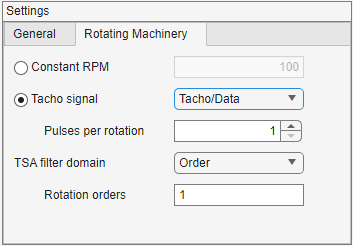
Once you are satisfied with the configuration and the settings, click Compute.
View New Variables and Ranked Features
When the feature computations are complete, the app plots the feature ranking. The Variables pane includes new derived variables that the app computed to support feature generation. For example, in the following figure, two new derived spectrum variables provide sources for spectral features.

You can use Compact view to view more variables in the same
space. Right-click on any variable to access the compact view option. In the following
figure, selecting Compact view collapses each variable to the
main variable name.

The derived variable names include the last processing step that was used to compute
them. For example, in the following figure, Vibration_res is a
residual signal that is computed by subtracting a reference signal
such as the mean value of the signal ensemble.
To view the generated features, scroll down in the Variables pane.
To obtain more information about a feature, such as what variable the feature is derived
from, select the feature and then view the feature information in the
Details pane. You can also use the Details pane
for information on variables. In the following figure, the Details pane
shows that the ClearanceFactor feature from the
Vibration_res_sigstats feature group is derived from the
Vibration_res signal.
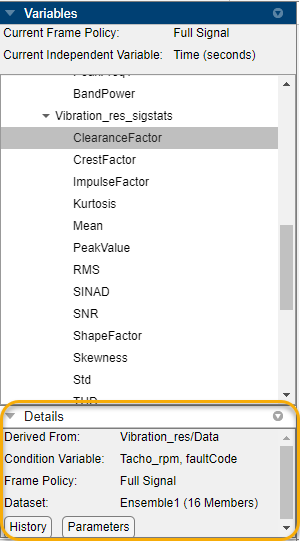
To view more information about the processing history of a feature, click
History. The following figure illustrates the sequence of serial
and parallel processing steps that led to ClearanceFactor.

For some features, the app uses tunable parameters in the computation. To view the
parameter values, click Parameters. The following figure shows the
parameter values for the spectral feature PeakAmp1.
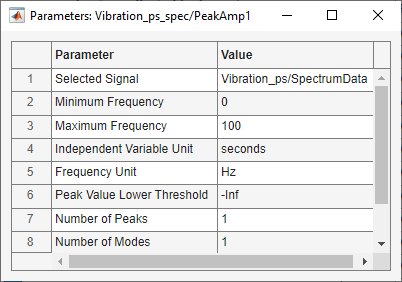
If you selected the option to plot histograms automatically, you can view them by selecting the Histogram plot tab next to the Feature Ranking plot tab.
Add Additional Variables and Features
After you generate your first set of features using Auto Features, you can continue to select variables for automatic or manual processing and feature extraction. If you apply Auto Features to variables that Auto Features previously derived, the new features will be duplicates. However, if you create new variables yourself, Auto Features generates distinct features.
For example, the default spectral processing option that Auto
Features uses is Welch. Suppose that you create a separate
spectrum variable using the Autoregressive option. Select that new
spectrum, Vibration_ps_1, for Auto Features to see
that there are three available features. Since Auto Features did not
use this spectrum variable to generate the initial feature set, these features are distinct
from the spectral features that Auto Features generated
previously.
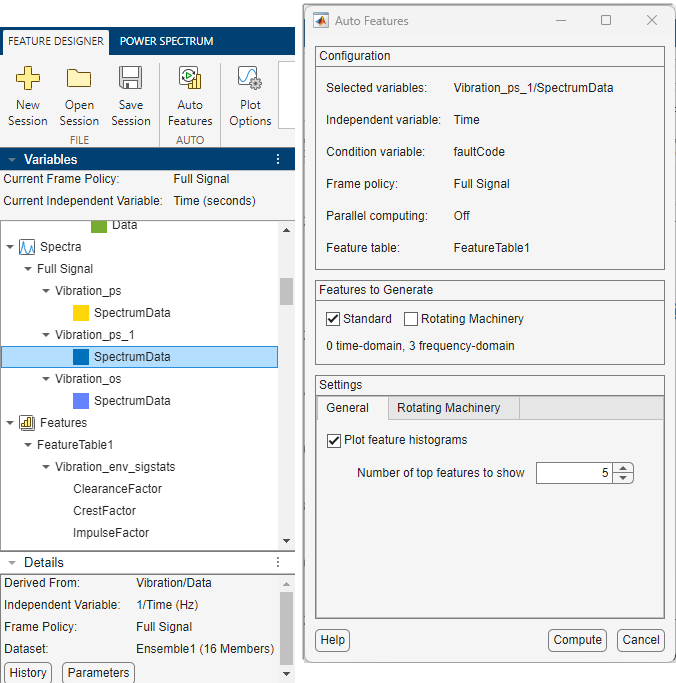
The new features are ranked along with the existing features. In the following figure, two of the new spectral features are ranked eighth and ninth.
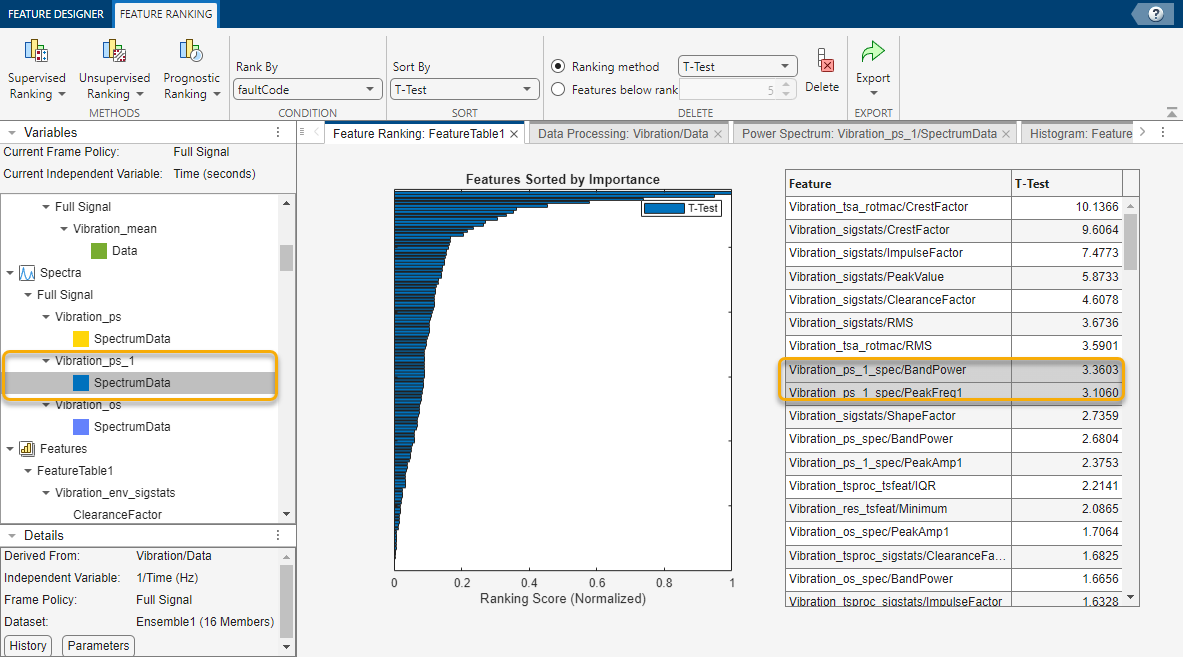
Because Auto Features dialog box for this example is set to the
default value of 5, the set of histogram plots for FeatureTable1 does not
include the new features. If you decide you want to see additional histograms, select the
feature table. Then, in the Histogram tab, click Select
Features.
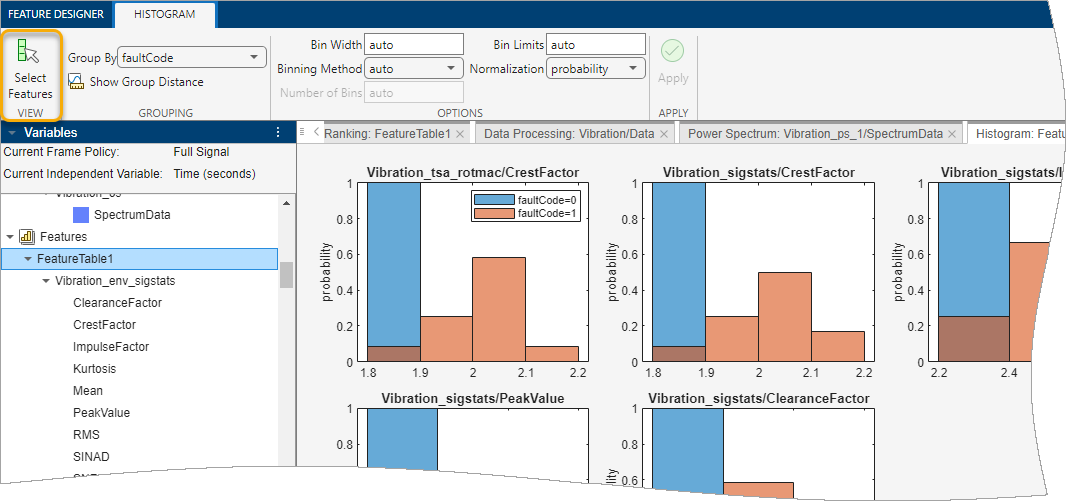
A dialog box that displays the features in ranked order allows you to select additional features.

For more information on Select Features, see Feature Selector.
Delete Features from App
When you use Select Features, you hide features that you do not select, but they remain in the feature table. You can also delete features completely from the app. Use this capability to permanently remove features that you do not want to view or use.
The app provides multiple ways to delete features:
By name: In the Variables pane, select a feature, features, or feature table to delete by name. Right-click and then select
Delete Features.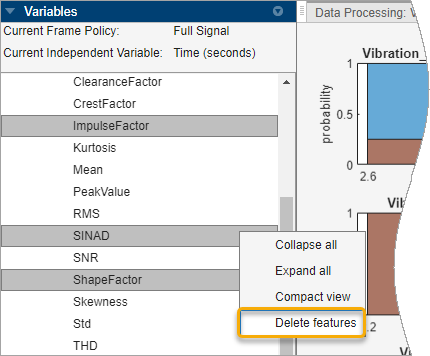
By rank: In the Feature-Ranking tab, delete features using one of the following methods:
Select low-ranked features in the ranking table, right-click, and select
Delete Features.In the Delete section of the tab, specify the ranking method to use as a deletion criterion. Then, specify the lowest ranking position to retain and click Delete. The app deletes all features that are ranked below the specified position. For example, if there are 13 features and you specify a rank of
5, then the app deletes the lowest eight features.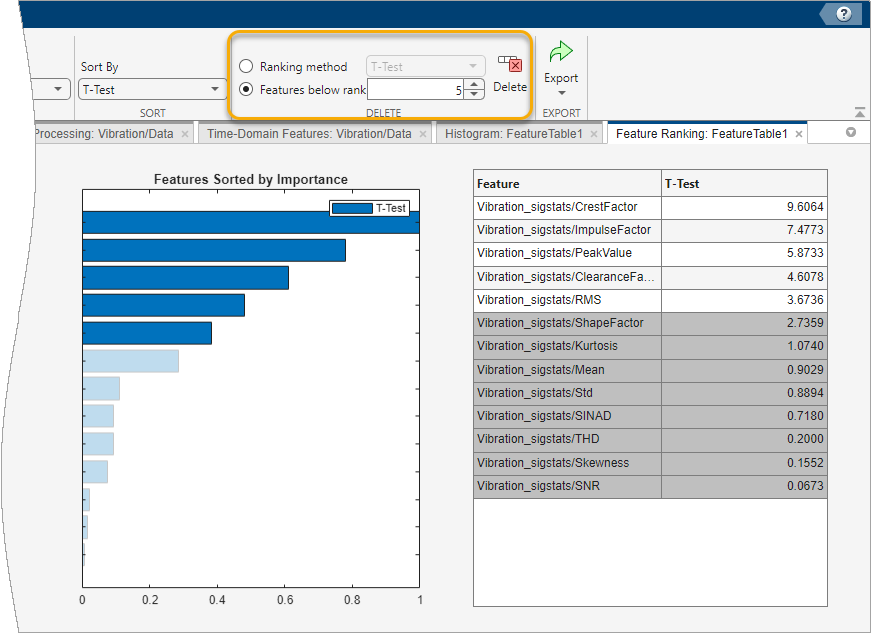
When the app deletes the features, it also removes the features from previously generated plots, such as histogram or feature trace plots.
Next Steps
You can now continue to process your variables and add new features. You can also export your feature set to your MATLAB® workspace or to Classification Learner.
